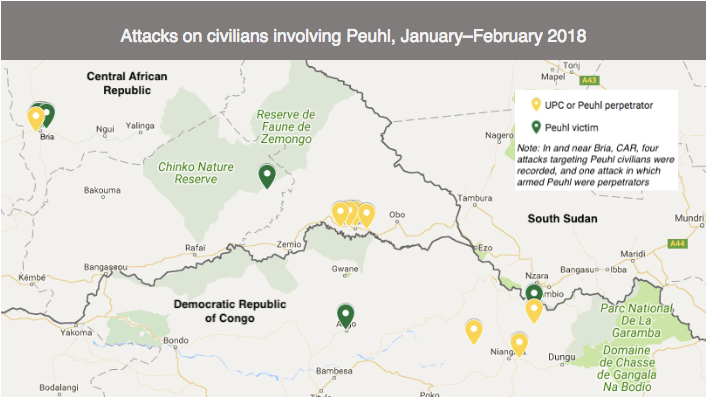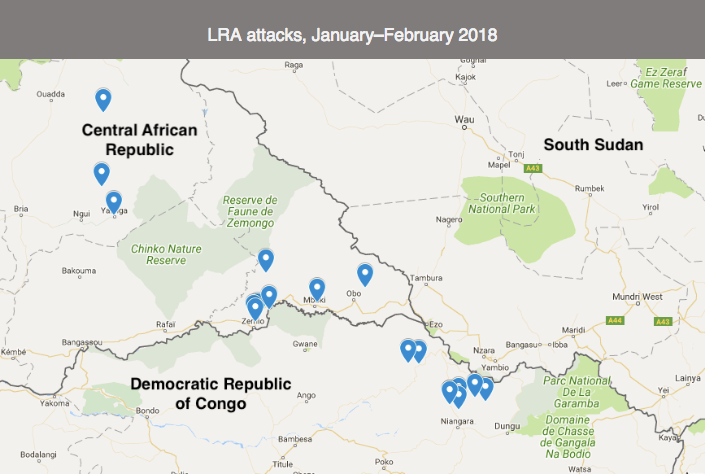Pour lire la version française de ce rapport, cliquez ici.
There were at least 22 attacks on civilians in the Mbomou Uele border region in January 2018, in which at least five civilians were killed and 26 others abducted. In February, there were 30 attacks, killing at least 15 civilians and abducting 25 others. One of the most significant changes in January–February 2018 relative to comparable periods in previous years was the dramatic reduction in LRA activity, particularly abductions. There was also an increase in violent incidents involving the Peuhl minority, including seven attacks targeting PeuhI civilians and eight attacks in which armed Peuhl or the majority-Peuhl ex-Seleka faction, the Union pour la Paix en Centrafrique (UPC), were responsible.

Violent incidents involving Peuhl highlight tensions in CAR, DRC
Members of the Peuhl minority were involved in more than 40% of all non-LRA attacks on civilians from January–February 2018 in the Mbomou Uele border region. The Peuhl minority in eastern CAR and northeastern DRC is very diverse, composed of myriad sub-groups, and violent incidents are heavily influenced by local conflict dynamics, making it difficult to draw broadly conclusive patterns. While tensions between Peuhl and other groups have existed in the region for many years, there has undoubtedly been an increase in violence and intercommunal tension involving Peuhl over the past year, particularly in eastern CAR. Only three violent incidents involving Peuhl were recorded fom January–February 2017, compared to 15 from January–February 2018.
Armed Peuhl or fighters from the UPC were responsible for four attacks on civilians in eastern CAR from January–February 2018, with three of those attacks occurring in or near the UPC-controlled town of Mboki in Haut Mbomou prefecture. In Haute Kotto prefecture, Peuhl were more often the targets rather than the perpetrators of violence. On January 3, anti-balaka forces killed three Peuhl men and severely injured three others who were traveling towards the town of Bria. Anti-balaka forces near Bria attacked Peuhls on at least three other occasions in February.
In DRC, there were four violent incidents involving Peuhl. One incident in particular highlighted many of the complex conflict dynamics involving Peuhl in DRC. On January 25, a group of armed South Sudanese men attacked a group of Peuhl pastoralists in a remote Congolese forest between Bangadi, DRC, and Sakure, South Sudan. The South Sudanese men killed several of the pastoralists’ cows. The pastoralists went into hiding in the bush, but eventually decided to return to retrieve the cow meat. However, when they arrived, they found that the South Sudanese were already collecting the meat. The two groups clashed and at least 6 South Sudanese men were killed. As the pastoralists were on their way back to their homes, they came across a group of Congolese fishermen. In the ensuing confusion, the pastoralists fired at the fishermen, killing a Congolese man.

Dry season LRA violence reduced in 2018 compared to previous years
Since 2010, the LRA has traditionally been more violent in January and February, the peak of the dry season, than in most other months of the year. From January–February 2016, the LRA abducted 306 civilians in 60 attacks, including a surge in child abductions ordered by LRA leader Joseph Kony. In 2017, LRA activity in the first two months of the year was reduced, with 32 attacks and 133 abductions. In 2016, January ranked first and February third among all months regarding the number of LRA abductions. In 2017, January ranked third and February ranked first.
LRA forces abducted 42 civilians in 19 attacks from January–February 2018, a sharp reduction compared to 2017 and, in particular, 2016. Still, the relatively low number of LRA abductions from January–February 2018 does not necessarily reflect a reduction in the group’s capacity to ramp up abductions should they choose to do so. LRA abductions have dipped in the past, such as from January–February 2013 (65 abductions), only to rise again during the dry season in subsequent years. In addition, few of the Ugandan male fighters that comprise the LRA’s core have defected in recent years, including only one since March 2017.
Activity in LRA hotspots could help predict future threats to civilians
Though LRA activity from January–February 2018 was reduced in comparison to previous years, the group remained a significant threat to civilians across a vast swath of territory. In CAR, among the most violent LRA incidents were two mid-February attacks targeting remote communities east of Bria in Haute Kotto prefecture. During a February 13 attack on the twin communities of Ngui 1 and Ngui 2, LRA forces abducted 12 adults and one child, releasing the adults after forcing them to porter looted goods but keeping the child in captivity. Such relatively large-scale LRA attacks in recent years have often been the work of LRA combatants that are under orders to collect large amounts of supplies and bring them back to Kony. Communities east of Bria could experience further attacks in March if Kony has recently given similar orders.
A separate LRA group was responsible for five attacks along the CAR–DRC border between the towns of Zemio and Mboki, including the January 12 abduction of two Congolese and five Central African men who were forced to porter looted goods. This area has been targeted in recent years by the Achaye Doctor LRA splinter group, which has frequently operated further south in DRC’s Bas Uele province as well, raising the possibility that LRA activity in the coming weeks will move south through communities in and near the Bili Uele Protect Area Complex.
The LRA was also active in the triangle of territory between Niangara, Bangadi, and Ngilima in DRC’s Haut Uele province, an area that has long been a favorite target of LRA commanders. In May 2016, it was targeted by LRA groups moving southwest from CAR towards DRC’s Garamba National Park. The recent activity there could indicate that communities closer to the park, further east, could be at risk in the coming weeks and months.

The LRA Crisis Tracker is a project of Invisible Children that incorporates data on armed group activity in the Mbomou-Uele border region, a geographic area that includes the prefectures of Haute Kotto, Mbomou, and Haut Mbomou in eastern CAR and areas of Haut Uele and Bas Uele provinces in northeastern DRC north of the Uele River. Information on armed group activity from neighboring areas of CAR, DRC, South Sudan, and Sudan is incorporated into our analysis of conflict dynamics in the Mbomou-Uele border region. Visit the LRA Crisis Tracker website at www.LRAcrisistracker.com
This report is made possible by the support of the American People through the United States Agency for International Development (USAID). The contents of this report are the sole responsibility of Invisible Children and do not necessarily reflect the views of USAID or the United States Government.

Think people should hear about this?